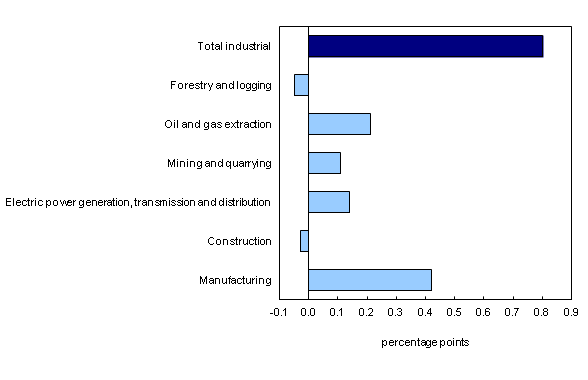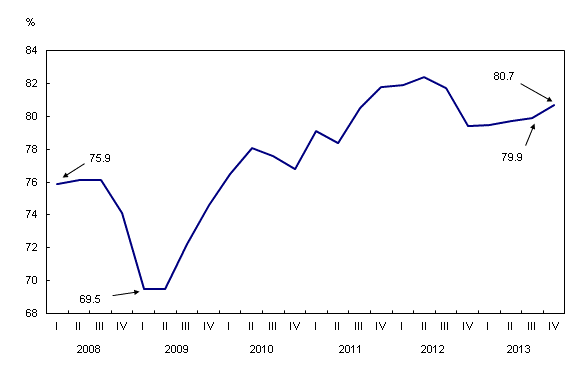Industrial capacity utilization rates, fourth quarter 2013 and annual 2013
Archived Content
Information identified as archived is provided for reference, research or recordkeeping purposes. It is not subject to the Government of Canada Web Standards and has not been altered or updated since it was archived. Please "contact us" to request a format other than those available.
Released: 2014-03-13
Canadian industries operated at 82.0% of their production capacity in the fourth quarter, up from 81.2% in the third quarter. The manufacturing and oil and gas extraction industries were the main sources of this increase.
Manufacturing led upward by the transportation equipment and food industries
The manufacturing sector was the main source of growth in the capacity utilization rate in the fourth quarter, accounting for more than half of the overall increase.
The manufacturing sector operated at 80.7% of its capacity in the fourth quarter, up 0.8 percentage points from the third quarter. The transportation equipment manufacturing and food manufacturing industries were largely responsible for this increase.
Of the 21 major groups in the manufacturing sector, 9 increased their capacity utilization. Capacity use was down in 12 industries, notably the fabricated metal products industry and the computer and electronic product manufacturing industry.
In the transportation equipment manufacturing industry, the rate rose 3.0 percentage points to 90.6% in the fourth quarter. Higher production of motor vehicles and motor vehicle parts and of aerospace products and parts was the main source of this increase.
For food manufacturers, capacity use rose from 74.2% to 77.5% in the fourth quarter. This increase was due to higher production in every subsector of the industry, except dairy product manufacturing and sugar and confectionery product manufacturing.
Non-manufacturing industries: The oil and gas extraction industry leads the increase for a second consecutive quarter
As in the third quarter, the oil and gas extraction industry was the predominant source of growth in the capacity utilization rate for non-manufacturing industries in the fourth quarter.
Higher extraction of non-conventional crude petroleum was primarily responsible for pushing the oil and gas extraction industry's capacity utilization rate up 1.5 percentage points to 87.5%.
After declining for eight consecutive quarters, the mining and quarrying industry's capacity utilization was up 1.5 percentage points to 63.1%, as a result of an increase in metallic and non-metallic mineral production.
Higher demand for electricity was responsible for an increase in the electric power generation, transmission and distribution industry's capacity use, which rose 1.6 percentage points to 89.1%.
Reduced activity in the forestry and logging industry accounted for the 3.2 percentage-point decline in its capacity utilization rate to 86.2% in the fourth quarter.
Average annual rate down for the first time since 2009
Compared with 2012, the average capacity utilization rate of Canadian industries fell 0.2 percentage points to 81.3% in 2013, the first annual decrease since 2009.
The average annual rate in the manufacturing sector was 80.0% in 2013, down from 81.4% in 2012. This decline was partly offset by the increase posted by non-manufacturing industries.
Mining was the lone non-manufacturing industry with a lower capacity utilization rate compared with 2012, edging down 0.1 percentage points to 62.9% in 2013. This was the second consecutive annual decrease for this industry.
Compared with 2012, the industries with the largest percentage-point gains in capacity use in 2013 were wood product manufacturing, furniture and related product manufacturing, and forestry and logging. The largest declines were in machinery and fabricated metal products.
Note to readers
The industrial capacity utilization rate is the ratio of an industry's actual output to its estimated potential output.
For most industries, the annual estimates are obtained from the Capital and Repair Expenditures Survey while the quarterly pattern is derived from output-to-capital ratio series, the output being the real gross domestic product at basic prices, seasonally adjusted, by industry.
This program covers all manufacturing and selected non-manufacturing industries.
With this release on industrial capacity utilization rates, data were revised back to the first quarter of 2013 to reflect updated source data.
Data on industrial capacity utilization rates for the first quarter will be released on June 12.
Contact information
For more information, or to enquire about the concepts, methods or data quality of this release, contact us (toll-free 1-800-263-1136; 514-283-8300; infostats@statcan.gc.ca) or Media Relations (613-951-4636; statcan.mediahotline-ligneinfomedias.statcan@canada.ca).
- Date modified:



